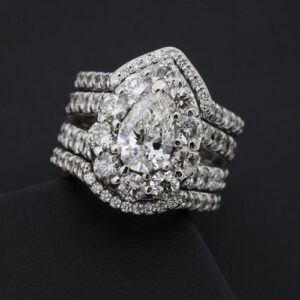Average Diamond Carat Weight
What’s A Diamond Carat, To Begin With?
 One of the most misunderstood things about diamonds is the term “carat.” A carat is the weight of a diamond, not its size. Contrary to what many people think, large carat weight isn’t always better than small carat weight. While it is for the fact that a bigger rock is a status symbol, carat weight has nothing to for with the sparkle of the rock. In fact, raw diamonds obtained straight from the mine seldom sparkle. The sparkle is a result of cutting and polishing y experts. Hence, a high carat diamond with a noticeable poor cut can look smaller than another diamond with a small carat and very nice cut.
One of the most misunderstood things about diamonds is the term “carat.” A carat is the weight of a diamond, not its size. Contrary to what many people think, large carat weight isn’t always better than small carat weight. While it is for the fact that a bigger rock is a status symbol, carat weight has nothing to for with the sparkle of the rock. In fact, raw diamonds obtained straight from the mine seldom sparkle. The sparkle is a result of cutting and polishing y experts. Hence, a high carat diamond with a noticeable poor cut can look smaller than another diamond with a small carat and very nice cut.
Price per carat
Diamonds with a higher carat weight are normally cut from large and rough crystals that are hard to source compared to small crystals. Hence, the relationship between price and carat weight depends on the availability or rarity of the rough crystal. As such, carat price can be a function of searching rough crystals that possess the desirable color, external, and internal characteristics that will have a positive influence on the clarity when the diamond is cut. There is a list of intricate factors you should keep in mind when selecting the best diamond by carat weight, here are the tips from experts themselves.
A brief history of the diamond carat
Back in ancient times, when the seeds of a full-grown Caron tree would be used to determine the weight of precious stones and metals, the term “carat” was adopted to denote the even weight. The 1907 Fourth General Conference, on Measures and Weight, it was agreed that 200 mg would be equal to 1 diamond carat. You can also measure carats in points, e.g., 100 points are equivalent to a full carat.
Things you need to know about the carat
Spend lavishly on the cut – This’s the mother of all factors you need to consider because it ensures that you walk away with pieces with the maximum sparkle. Even a higher carat stone with excellent clarity and color can appear dull and lifeless if its cut is poor.
“Buy shy’ and save money – Consider selecting a carat weight lying slightly below the half and whole-carat marks. For instance, it makes sense to buy a 1.90 carat stone instead of the exact 2.00 carat because the difference is unnoticeable, and you would have saved a lot of money with that tiny variance.
Fancy shapes are less costly per carat – You might be surprised by this, but fancy shaped diamonds tend to be less costly than equivalent round diamonds. It is also important to note that fancy shaped diamonds appear bigger than their real carat weight, more so when put in a halo surface.
Keep in mind the ring size – Did you know that the size of your finger influences how the ring appears? Yes, the smaller your finger is, the larger your diamond will appear. If you bought a 1.50 stone solitaire and tried it on sizes 8 and 6, it will look smaller on size 8 than size 6.
So, what is the average diamond ring size?
True to the words of marketers at Rio Tinto, a diamond ring is forever. While diamond rings do last forever, you can only pray you to get your specifications right, as some of the factors we often thing are definitive aren’t definitive at all. The most important factor to consider, however, is the weight of the diamond (more specifically, the carat weight of the diamond). Below we have glanced at the data obtained from various sources to determine how heavy (or how large) the average diamond is, assisting you in buying the best and highest quality ring that falls within your budget.
 There is no single entity or source that keeps track of the average size of the diamond ring worn by engaged people (and that’s understandable because it doesn’t look like a question you would put on the census form). This means what will discuss here will be part of a longer range instead of an exact figure.
There is no single entity or source that keeps track of the average size of the diamond ring worn by engaged people (and that’s understandable because it doesn’t look like a question you would put on the census form). This means what will discuss here will be part of a longer range instead of an exact figure.